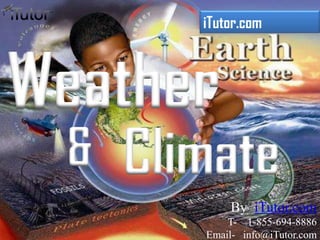More Related Content Similar to Weather and Climate (20) 2. Water in the atmosphere
Higher temperatures cause liquid water molecules to move
faster.
These water molecules become water vapor in the
atmosphere.
When liquid water is converted into water vapor, the
process is called evaporation.
As temperature increases
evaporation increases
Atmospheric Pressure increases
evaporation decreases
© iTutor. 2000-2013. All Rights Reserved
3. Cloud formation
Through the process of evaporation and transpiration,
water moves into the atmosphere.
Water vapors then join with dust particles to create clouds.
Different conditions cause different clouds.
Cumuliform clouds include:
Cirrocumulus
Altocumulus
Cumulus
Cumulonimbus
Cirrocumulus Altocumulus
Cumulus Cumulonimbus
© iTutor. 2000-2013. All Rights Reserved
4. Cloud formation
Stratiform clouds form when a large mass of stable
air gradually rises, expands, and cools.
Stratiform clouds include:
Cirrostratus
Altostratus
Stratus
Nimbostratus
Cirrostratus
Altostratus Stratus Nimbostratus
© iTutor. 2000-2013. All Rights Reserved
5. Cloud formation
Sometimes a cloud formation
combines aspects of both
cumuliform and stratiform
clouds.
We call these clouds
stratocumulus clouds.
Cirrus clouds are thin lines
of ice crystals high in the sky,
above 6,000 meters.
They are just a thin streak of
white across a blue sky.
Stratocumulus clouds
Cirrus clouds
© iTutor. 2000-2013. All Rights Reserved
6. Rain
Rain is the result of a cooling air
mass.
Cooling an air mass is like
wringing out a wet sponge.
Tiny droplets form a cloud or
fog.
Larger droplets fall as rain.
© iTutor. 2000-2013. All Rights Reserved
7. Snow
Snow usually forms when
both ice crystals and water
droplets are present in the
sky.
The water droplets attach to
ice crystals and freeze.
When the ice crystals are
large enough, they will fall
to the ground as snow.
© iTutor. 2000-2013. All Rights Reserved
8. Air masses and fronts
An air mass is a large body of air
with consistent temperature and
moisture characteristics
throughout.
Two air masses that affect the
United States are the continental
polar air mass and the maritime
tropical air mass.
© iTutor. 2000-2013. All Rights Reserved
9. Fronts
A cold front occurs when cold air moves in and
replaces warm air.
© iTutor. 2000-2013. All Rights Reserved
10. A warm front occurs when warm air moves in
and replaces cold air.
Fronts
© iTutor. 2000-2013. All Rights Reserved
11. Low- and high-pressure areas
When a cold front moves into
a region and warm air is
forced upward, an area of
low pressure is created near
Earth’s surface at the
boundary between the two
air masses.
A center of high pressure tends to be found where a stable
cold air mass has settled in a region.
© iTutor. 2000-2013. All Rights Reserved
12. Thunderstorms
Thunderstorms occur because of
convection in the atmosphere.
The downdraft and updraft form
a type of convection cell called a
storm cell within the cloud.
© iTutor. 2000-2013. All Rights Reserved
13. Lightning
Lightning is a bright spark of light that occurs within a
storm cloud, between a cloud and Earth’s surface, or
between two storm clouds.
© iTutor. 2000-2013. All Rights Reserved
14. Hurricanes
A hurricane is a tropical
cyclone with wind speeds of
at least 74 miles (119 km)
per hour.
The Saffir – Simpson
Hurricane Scale is one scale
used for rating hurricanes.
© iTutor. 2000-2013. All Rights Reserved
15. Tornadoes
A tornado, like a
hurricane, is a system
of rotating winds
around a low-pressure
center.
As the rotating wind
pattern narrows and
lengthens, it forms a
funnel cloud.
funnel cloud
© iTutor. 2000-2013. All Rights Reserved
16. Storm patterns across the globe can happen in cycles.
Usually the trade winds blow warm water from east to
west across the Pacific Ocean.
Every so often the trade winds weaken and the warm
water reverses direction.
El Nino Southern Oscillations
© iTutor. 2000-2013. All Rights Reserved
17. Along with warm water comes greater thunderstorm
activity across the Pacific.
This change in wind flow, air pressure, and thunderstorm
activity is known as the El Niño Southern Oscillation.
El Nino Southern Oscillations
© iTutor. 2000-2013. All Rights Reserved
19. Climate depends on
many factors:
latitude,
precipitation,
elevation,
topography, and
distance from large
bodies of water.
Biomes and climate
© iTutor. 2000-2013. All Rights Reserved
20. Scientists divide the planet into climate regions called
biomes.
Earth has six main biomes: deserts, grasslands, temperate
deciduous forests, rainforests, taiga, and tundras.
Each biome has a unique set of plants and animals that
thrive in its climate.
Biomes and climate
© iTutor. 2000-2013. All Rights Reserved
22. Each biome has a unique set of plants and animals that
thrive in its climate.
The Serengeti is home to thousands of predators species
and 1.6 million herbivores.
Biomes and climate
© iTutor. 2000-2013. All Rights Reserved
23. Humidity is related to
plant and animal
diversity.
From the poles to the
equator, humidity and
the diversity of plants
and animal increases.
Biomes and climate
© iTutor. 2000-2013. All Rights Reserved
24. At the equator, sunlight is
direct and intense.
As a result, the average
yearly temperature at the
equator is 27 °C (80 °F),
while at the North Pole it is
-18 °C (0 °F).
Biomes and climate
© iTutor. 2000-2013. All Rights Reserved
25. Plants and animals in biomes
A biome consists of plant and
animal communities.
The plants and animals in a
community survive in a shared
environment.
Within a biome, there are many
interrelated ecosystems.
An ecosystem is made up of the
plants and animals that live
there, plus nonliving things like
soil, air, water, sunlight, and
nutrients.
© iTutor. 2000-2013. All Rights Reserved
26. Meteorology
A meteorologist is a person who uses scientific principles to
explain, understand, observe, or forecast Earth’s weather.
Many meteorologists have college degrees in physics,
chemistry, or mathematics.
© iTutor. 2000-2013. All Rights Reserved
27. The End
Call us for more
Information
www.iTutor.com
Visit
1-855-694-8886
